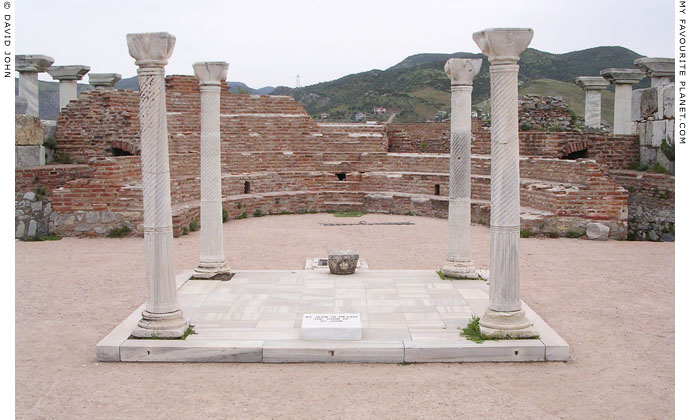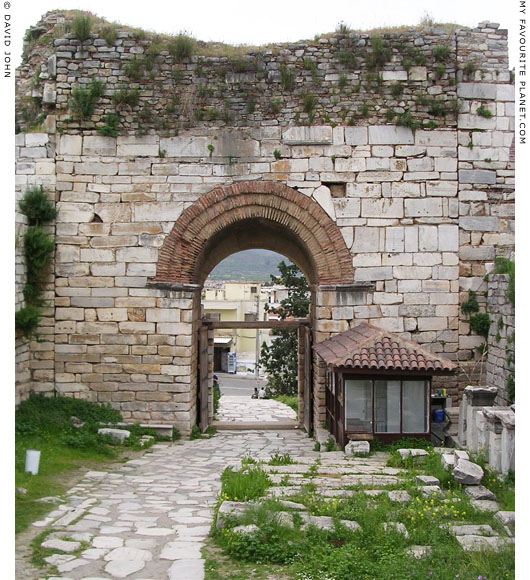|
|
|
| My Favourite Planet > English > Middle East > Turkey > Selçuk > photo gallery 1 |
| Selçuk gallery 1 |
Selçuk town |
 |
 |
5 of 30 |
 |
 |
|
| |

Marble area covering Saint John's grave in front of the apse in the Basilica of Saint John. |
| |
Saint John's Basilica, Selçuk
Open every day
Summer (April-October): 08:30 - 18:30
Winter (November-March) 08:00 - 17:00
Admission charge: 10 TL
The ruins of the Basilica of Saint John stand in a large fortified precinct at the foot of the acropolis of Ayasuluk. The entrance, the "Gate of Persecution" (see photo below), was built in the 6th century AD with material taken from the Hellenistic stadium of ancient Ephesus.
The story of the gate's name is unknown, but may well be associated with the history and legends of the early Christian martyrs of Ephesus. Another version has it that the name is taken from an ancient Greek relief, known as "The persecution of Hector by Achilles", which adorned the top of the arch on the outer side of the gate. A copy of this relief can now be seen in its place. It is not known when this stone frieze was built into the gateway, and it seems unlikely that it added in the 6th century - a time when the emperors themselves feared the wrath of the iconoclasts who abhorred pictorial representation.
The northern ends of the U-shaped fortifications around the basilica abut the walls of the Ayasuluk citadel to the north. These walls were strengthened during the 7th and 8th century when the area was under attack by Arabs.
According to Christian tradition, Saint John the Evangelist, Apostle of Jesus, came to Ephesus with the Virgin Mary from Jerusalem. John is thought to have lived here for many years until his death [1]. The Christian community established here by early believers, including Saint Paul the Apostle, was one of the "Seven Churches of the Apocalypse" addressed by the New Testament Book of Revelation and became a place of pilgrimage and miracle cures.
The shrine built around what is said to be John's grave was replaced by a larger church in the 4th century. During the 6th century, at the same time as the building of the Hagia Sophia in Constantinople (today Istanbul), the Byzantine emperor Justinian the Great (ruled 527-565) replaced that church with this enormous six-domed basilica, 130 metres long and 40 metres wide, the third largest Byzantine church. The basilica's dimensions were extraodinary for the time, indicating its importance to the Greek Orthodox Church and the Byzantine Empire, and almost match those of the Hagia Sofia and indeed the nearby Temple of Artemis.
During the 6th or 7th century the seat of the bishop of Ephesus was transferred here from the Aghia Maria Church.
Following the conquest of Ephesus by the Seljuk Turks, it was first converted to a mosque and later used as a bazaar until it was destroyed by an earthquake during the middle ages.
See also: The Aghia Maria (Church of the Virgin), Ephesus |
|
| |
| |

The inside of the "Gate of Persecution", the entrance
to the walled area around the Basilica of Saint John. |
| |
Saint John's
Basilica
Selçuk |
Notes, references and links |
 |
|
1. Saint John
According to some sources, Saint John the Apostle, one of Jesus Christ's original twelve disciples, came to Ephesus with the Virgin Mary from Jerusalem, and lived here until his death as late as 100 AD. If this is the case, it seems odd that Saint Paul the Apostle who visited here several times from around 52 AD makes no mention in his writings of either John or the Virgin Mary in connection with Ephesus. The only (inferred) reference to a meeting of Saint Paul and Saint John recorded in the Bible was at Jerusalem (Galatians 2:9).
Saint John has been given many names: the Apostle, the Evangelist, the Divine, the Theologian. All very confusing. This confusion may have to do with the identity of Saint John himself. There may have been two or even three Johns (a very common name also at that time). The first John was the disciple (or Apostle) of Jesus, also known as John the Divine. A second John, John the Evangelist, may have been the author of the Gospel of John (perhaps written in Ephesus). The third, John of Patmos, was the author of the Book of Revelation (The Apocalypse), thought to have been written 95-150 AD, which the author himself says was inspired by the vision he had on the island of Patmos, though he tells us no more about his identity or circumstances. All these Johns were later believed to have been the same person, and given the name John the Theologian.
So we find the Cave and Monastery of the Apocalypse on Patmos, where The Book of Revelation is believed to have been written, as well as the Monastery of Saint John the Theologian. While in Ephesus, the area around the Basilica of Saint John became known as Agios Theologos (in Greek Άγιος Θεολόγος), from which the Turkish name Ayasluğ (or Ayasuluk) is derived. The name of the citadel still carries this name, though the town was renamed Selçuk in 1914, to commemorate the Seljuk Turks who settled in the region in the 12th century.
In this case, faith may not have moved mountains, but it has moved a lot of stones and clay to build edifices which have moved millions of pilgrims and tourists, most of whom are probably not bothered about which John is which. |
|
|
Map, photos and articles: © David John,
except where otherwise specified.
Additional photos: © Konstanze Gundudis
All photos and articles are copyright protected.
Images and materials by other authors
have been attributed where applicable.
Please do not use these photos or articles without permission.
If you are interested in using any of the photos for your
website, project or publication, please get in contact.
Higher resolution versions are available on request. |
|
| |
 |
Visit the My Favourite Planet Group on Facebook.
Join the group, write a message or comment,
post photos and videos, start a discussion... |
|
|
| |
|
|
|